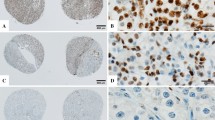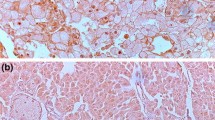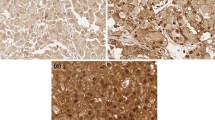Abstract
KISS-1 is a metastasis-suppressor gene of human melanoma, and encodes metastin, which was identified as the ligand of a G-protein-coupled receptor (metastin receptor). The precursor protein is cleaved to 54 amino acids, which may be further truncated into carboxy-terminal fragments. Previous studies showed that lack of metastin receptor in clear cell renal cell carcinoma (RCC) is associated with tumor progression, but the prediction of metastasis in patients with pT1 clear cell RCC after radical nephrectomy is difficult. The objective of this study was to evaluate the usefulness of metastin receptor immunohistochemistry in predicting metastasis after nephrectomy for pT1 clear cell RCC. After verification of the correlation between immunostaining and mRNA expression, we evaluated the clinical value of metastin receptor immunohistochemistry. Fifty-four patients were enrolled in this study; following radical nephrectomy, seven patients were found to have lung metastasis. The sensitivity, specificity, positive predictive value, and negative predictive value with negative immunostaining of metastin receptor were 85.7, 97.6, 46.2, and 97.6 %, respectively. Metastasis-free survival rates were significantly higher in patients with positive staining (97.6 %) than in patients with negative staining (53.8 %) (P < 0.001). In univariate analysis for metastasis-free survival, negative immunostaining of metastin receptor was a significant risk factor for metastasis (P = 0.001). Furthermore, negative immunostaining of metastin receptor was an independent predictor for metastasis in multivariate analysis (hazard ratio, 3.735; 95 % CI 0.629–22.174; P = 0.002). In conclusion, our study suggests that negative expression of metastin receptor in clear cell RCC is significantly related to metastasis.



Similar content being viewed by others
References
West A, Vojta PJ, Welch DR, Weissman BE (1998) Chromosome localization and genomic structure of the KiSS-1 metastasis suppressor gene (KISS1). Genomics 54:145–148
Ohtaki T, Shintani Y, Honda S, Matsumoto H, Hori A, Kanehashi K, Terao Y, Kumano S, Takatsu Y, Masuda Y, Ishibashi Y, Watanabe T, Asada M, Yamada T, Suenaga M, Kitada C, Usuki S, Kurokawa T, Onda H, Nishimura O, Fujino M (2001) Metastasis suppressor gene KiSS-1 encodes peptide ligand of a G-protein-coupled receptor. Nature 411:613–617
Shoji S, Tang XY, Sato H, Usui Y, Uchida T, Terachi T (2010) Metastin has potential as a suitable biomarker and novel effective therapy for cancer metastasis (Review). Oncol Lett 1:783–788
Roseweir AK, Millar RP (2009) The role of kisspeptin in the control of gonadotrophin secretion. Hum Reprod Update 15:203–212
Shoji S, Tang XY, Umemura S, Itoh J, Takekoshi S, Shima M, Usui Y, Nagata Y, Uchida T, Osamura RY, Terachi T (2009) Metastin inhibits migration and invasion of renal cell carcinoma with overexpression of metastin receptor. Eur Urol 55:441–449
Chen Y, Yusenko MV, Kovacs G (2011) Lack of KiSS1R expression is associated with rapid progression of conventional renal cell carcinoma. J Pathol 223:46–53
Wallen EM, Pruthi RS, Joyce GF, Wise M (2007) Urologic diseases in America project. Kidney cancer. J Urol 177:2006–2018
Levy DA, Slaton JW, Swanson DA, Dinney CP (1998) Stage specific guidelines for surveillance after radical nephrectomy for local renal cell carcinoma. J Urol 159:1163–1167
Ljungberg B, Alamdari FI, Rasmuson T, Roos G (1999) Follow-up guidelines for nonmetastatic renal cell carcinoma based on the occurrence of metastases after radical nephrectomy. BJU Int 84:405–411
Lam JS, Leppert JT, Figlin RA, Belldegrun AS (2005) Surveillance following radical or partial nephrectomy for renal cell carcinoma. Curr Urol Rep 6:7–18
Lau WK, Cheville JC, Blute ML, Weaver AL, Zincke H (2002) Prognostic features of pathologic stage T1 renal cell carcinoma after radical nephrectomy. Urology 59:532–537
Adamy A, Chong KT, Chade D, Costaras J, Russo G, Kaag MG, Bernstein M, Motzer RJ, Russo P (2011) Clinical characteristics and outcomes of patients with recurrence 5 years after nephrectomy for localized renal cell carcinoma. J Urol 185:433–438
Edge SB, Compton CC (2005) The American joint committee on cancer: the 7th edition of the AJCC cancer staging manual and the future of TNM. Ann Surg Oncol 173:918–921
Oken MM, Creech RH, Tormey DC, Horton J, Davis TE, McFadden ET, Carbone PP (1982) Toxicity and response criteria of the Eastern cooperative oncology group. Am J Clin Oncol 5:649–655
Uzzo RG, Novick AC (2003) Surveillance strategies following surgery for renal cell carcinoma. In: Belldegrum A, Ritchie AWS, Figlin RA, Oliver RTD, Vaughan ED Jr (eds) Renal and adrenal tumors: biology and management. Oxford University Press, Oxford, pp 324–330
Stephenson AJ, Chetner MP, Rourke K, Gleave ME, Signaevsky M, Palmer B, Kuan J, Brock GB, Tanguay S (2004) Guidelines for the surveillance of localized renal cell carcinoma based on the patterns of relapse after nephrectomy. J Urol 172:58–62
Eichelberg C, Junker K, Ljungberg B, Moch H (2009) Diagnostic and prognostic molecular markers for renal cell carcinoma: a critical appraisal of the current state of research and clinical applicability. Eur Urol 55:851–863
Choisy-Rossi C, Yonish-Rouach E (1998) Apoptosis and the cell cycle: the p53 connection. Cell Death Differ 5:129–131
Zigeuner R, Ratschek M, Rehak P, Schips L, Langner C (2004) Value of p53 as a prognostic marker in histologic subtypes of renal cell carcinoma: a systematic analysis of primary and metastatic tumor tissue. Urology 63:651–655
Cho DS, Joo HJ, Oh DK, Kang JH, Kim YS, Lee KB, Kim SJ (2005) Cyclooxygenase-2 and p53 expression as prognostic indicators in conventional renal cell carcinoma. Yonsei Med J 46:133–140
Kankuri M, Söderström KO, Pelliniemi TT, Vahlberg T, Pyrhönen S, Salminen E (2006) The association of immunoreactive p53 and Ki-67 with T-stage, grade, occurrence of metastases and survival in renal cell carcinoma. Anticancer Res 26:3825–3833
Gerdes J, Lemke H, Baisch H, Wacker HH, Schwab U, Stein H (1984) Cell cycle analysis of a cell proliferation-associated human nuclear antigen defined by the monoclonal antibody Ki-67. J Immunol 133:1710–1715
Kankuri-Tammilehto MK, Söderström KO, Pelliniemi TT, Vahlberg T, Pyrhönen SO, Salminen EK (2010) Prognostic evaluation of COX-2 expression in renal cell carcinoma. Anticancer Res 30:3023–3330
Taketo MM (1998) Cyclooxygenase-2 inhibitors in tumorigenesis (part I). J Natl Cancer Inst 90:1529–1536
Pruthi RS, Derksen E, Gaston K (2003) Cyclooxygenase-2 as a potential target in the prevention and treatment of genitourinary tumors: a review. J Urol 169:2352–2359
Potter C, Harris AL (2004) Hypoxia inducible carbonic anhydrase IX, marker of tumour hypoxia, survival pathway and therapy target. Cell Cycle 3:164–167
Sandlund J, Oosterwijk E, Grankvist K, Oosterwijk-Wakka J, Ljungberg B, Rasmuson T (2007) Prognostic impact of carbonic anhydrase IX expression in human renal cell carcinoma. BJU Int 100:556–560
Sakai I, Miyake H, Takenaka A, Fujisawa M (2009) Expression of potential molecular markers in renal cell carcinoma: impact on clinicopathological outcomes in patients undergoing radical nephrectomy. BJU Int 104:942–946
Leroy X, Zerimech F, Zini L, Copin MC, Buisine MP, Gosselin B, Aubert JP, Porchet N (2002) MUC1 expression is correlated with nuclear grade and tumor progression in pT1 renal clear cell carcinoma. Am J Clin Pathol 118:47–51
O-Charoenrat P, Rhys-Evans P, Modjtahedi H, Court W, Box G, Eccles S (2000) Overexpression of epidermal growth factor receptor in human head and neck squamous carcinoma cell lines correlates with matrix metalloproteinase-9 expression and in vitro invasion. Int J Cancer 86:307–317
Wesseling J, van der Valk SW, Vos HL, Sonnenberg A, Hilkens J (1995) Episialin (MUC1) overexpression inhibits integrin-mediated cell adhesion to extracellular matrix components. J Cell Biol 129:255–265
Taylor-Papadimitriou J, Burchell J, Miles DW, Dalziel M (1999) MUC1 and cancer. Biochim Biophys Acta 1455:301–313
Acknowledgments
The authors would like to sincerely express their appreciation to Norihide Mochizuki and Tomohisa Machida for their technical assistance in the immunohistochemistry studies.
Author information
Authors and Affiliations
Corresponding author
Rights and permissions
About this article
Cite this article
Shoji, S., Nakano, M., Tomonaga, T. et al. Value of metastin receptor immunohistochemistry in predicting metastasis after radical nephrectomy for pT1 clear cell renal cell carcinoma. Clin Exp Metastasis 30, 607–614 (2013). https://doi.org/10.1007/s10585-012-9564-3
Received:
Accepted:
Published:
Issue Date:
DOI: https://doi.org/10.1007/s10585-012-9564-3




